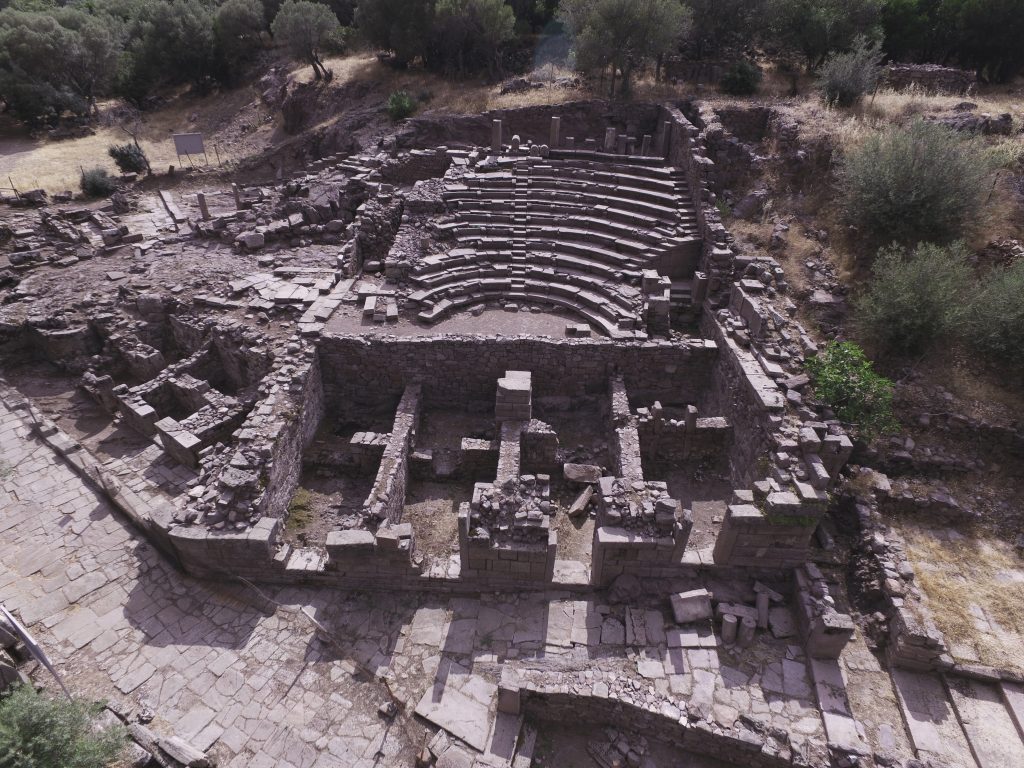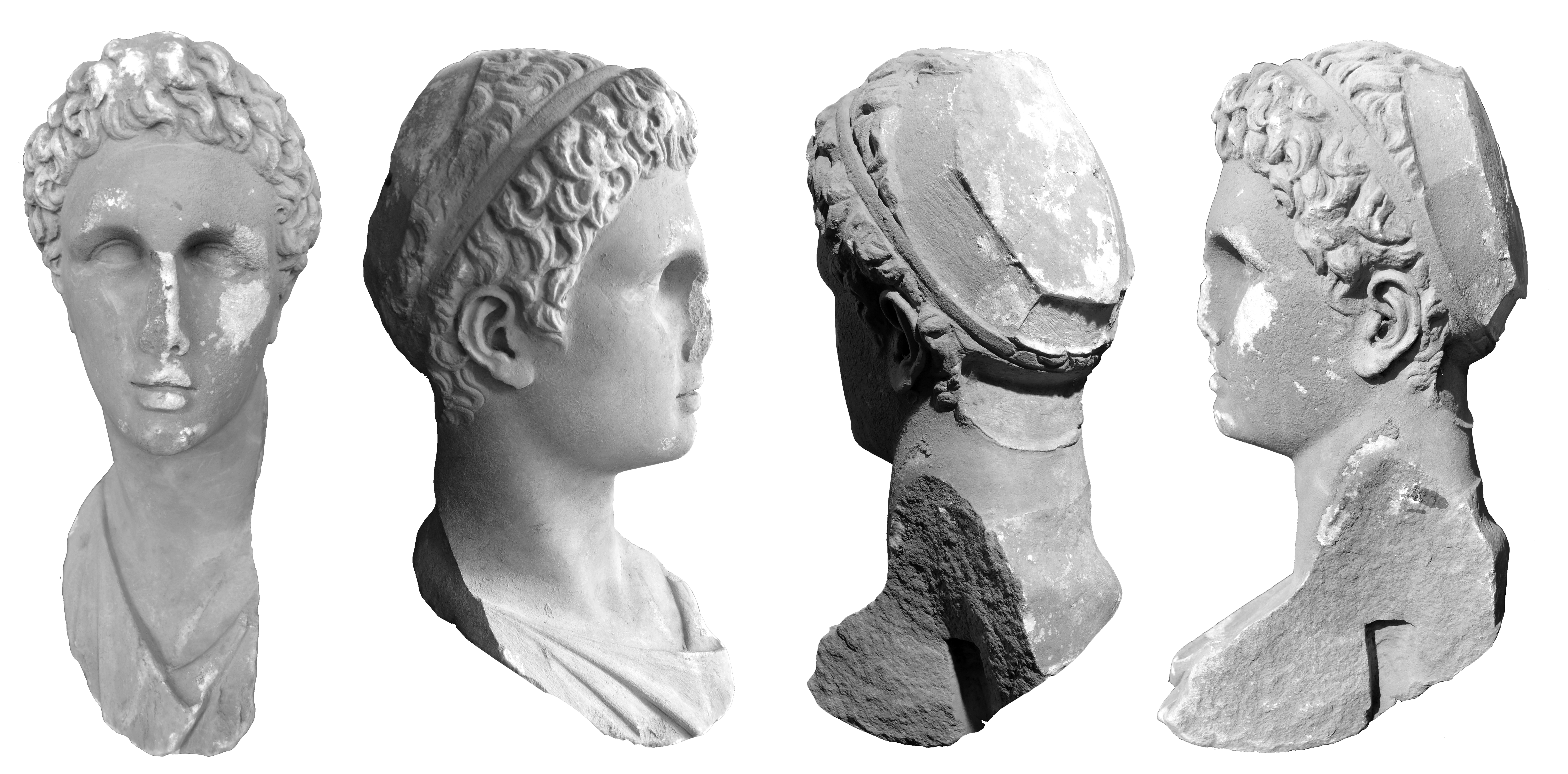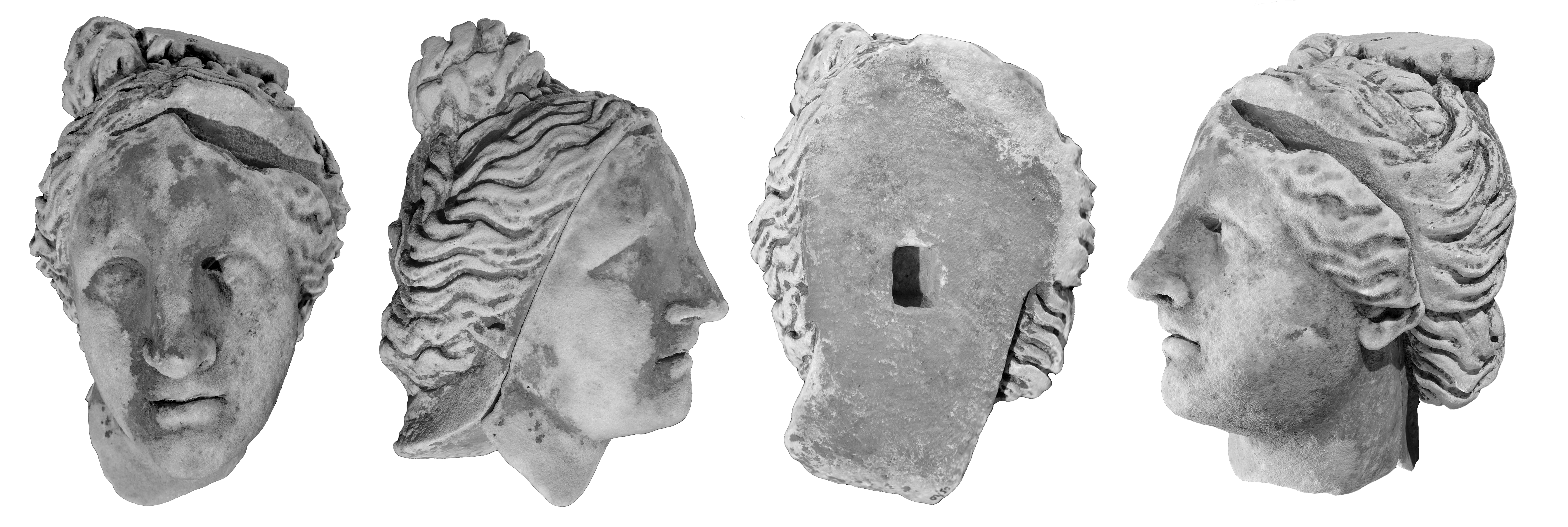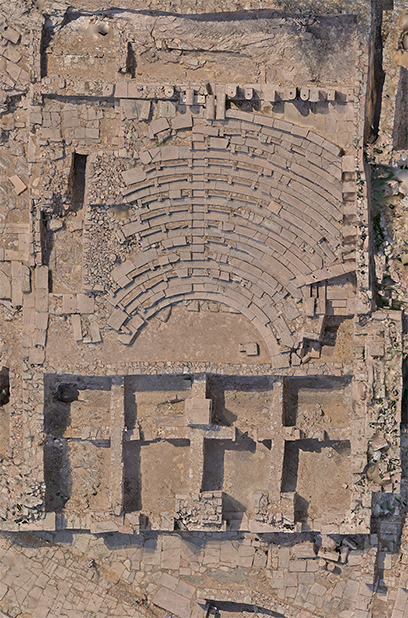
The first data on Bouleuterion has been obtained by the Pergamon excavation team’s research in 1886. An inscribed architrave block found near the Bouleuterion shows that a building was dedicated to Zeus Bollaios, Hestia Bollaia and the demos (the community of citizens) by Antiphanes son of Apollonidas. There is no doubt that this inscribed block was on the façade of Bouleuterion before it was destroyed.
.jpg)
The Bouleuterion was located on the side of the main street (Agora Street) which reaches to Upper Agora. It was built in the east-west axis on a sloping area. The structure is measured 24×14 m and has three main sections. In the western entrance of Bouleuterion, there is a backstage consisting of a gallery with six Ionic columns. Cavea has twelve seat rows and can accommodate about one hundred and ninety people. Semi-circle orchestra lays in front of the cavea. In terms of general structure and plan features, Aigai’s Bouleuterion has a similar structure to odeon buildings. However, the inscription on the architrave block, cult statue of Hestia Bollaia New Bouleuterion The first data on Bouleuterion has been obtained by the Pergamon excavation team’s research in 1886. Aigai 49 and absence of any trace of a stage building proves that the building cannot be an odeon. Stairways on both sides and center of the cavea area give access to the orchestra. Four chambers consisting of two rooms are located at the east of the orchestra, below the orchestra’s level. Two-winged entrances of the chambers are on the façade of the building facing Agora Street. Front and back rooms of the chambers are connected with single-winged doors. The function of the chambers is not clear for now.

The statue of Hestia Bollaia was erected on a pillar situated on the bedrock in the central part of the orchestra. The pillar was elevated to the floor level of the orchestra with a pedestal made of big, rectangular stone blocks. The statue was discovered overturned in front of the platform (east). Because the Hestia cult is also associated with Prytaneion, the building was probably used both as Bouleuterion and Prytaneion. The platform, which is located on also a bothros, a pit carved in the bedrock, was rising to the walking level of the orchestra. Lagynos, single handled jug, bowl as well as vessels, sixteen bronze coins, terra-cotta figurines, oil lamps, spindle whorls and brazier fragments were found in the bothros. The findings recovered from the bothros suggest a ceremony held to consecrate the construction of the building and dated to the middle of the 2nd century BCE regarded as terminus ante quem. Some artifacts associated with the last phase of usage of the Bouleuterion were discovered on the floor of peristhasis located between the Bouleuterion and rooms built at the northwest corner of the building. Besides the pottery dated to 3rd century CE, bronze coins dated to the period of Valerianus-Gallienus (253-268 CE) and Alexander Severus-Philippus Arabs (222-249 The Bouleuterion was located on the side of the main street which reaches to Agora Square. It was built in the east-west axis on a sloping area. The Buildings in Aigai 50 Bouleuterion Plan N Bothros, Old Bouleuterion Old Bouleuterion Bothros, New Bouleuterion Base of Hestia Statue Honorofic Statues Aigai 51 The Buildings in Aigai 52 CE) are associated with the last phase of usage of the Bouleuterion.

Six portrait heads and their bodies were found in the rubble. The statues were stood on piers which were located in a niche formed into the north wall of the Bouleuterion. More remarkably, inscriptions on the statues that read “Μενέστρατος Ἰππίου Περγαμηνος ἐποίει” indicate that at least two of these statues were produced by “Menestratas, the son of Hippias of Pergamon”

Traces of an earlier structure under the Bouleuterion were detected by soundings done on the destroyed southern part of the cavea, orchestra and backstage of the building. The early building was severely damaged during the construction of the Bouleuterion and the in-situ finds related to this structure are very limited. Floor of the earlier structure was discovered under the narrow area just west of the east wall of the backstage. A mold-made jug dated to the late 3rd century and early 2nd century BCE was found below the floor. The jug gives the terminus for the last phase of usage of the building. Another bothros detected with the sounding in the orchestra. Coarse and fine ware, animal bones found in the bothros suggest a ritual feast was given before the construction of the early building. Dateable finds point to the late 4th century BCE.

The early building whose traces can be detected in very limited areas had a different plan than the Bouleuterion building still partially stands and was built shortly after the middle of the 2nd century BCE. This early structure in question is thought to belong to a small-sized Bouleuterion building. Bothros finds from the end of the 4th century BCE show that the first Bouleuterion of Aigai was built on this date.

Early Bouleuterion were replaced with the bigger bouleuterion building during the extensive building activity in the city at the end of the 2nd century BCE. Antiphanes and Diaphenes, who supported the construction of the Bouleuterion were honored with the title of benefactor (euergetes) and their sculptures with other family members were placed in the niche on the north wall of the building, with sculptures. It is honored by displaying on a niche. The pedestal and sculptures were uncovered in the rooms in front of the Bouleuterion.

The Bouleuterion, which was in use until the 3rd century CE, for five centuries, has undergone many repairs as a result of damages caused by earthquakes. Different masonry techniques were used together on the inner face of the walls and especially on the entire south wall. When the city was abandoned in the third quarter of the 3rd century CE, the Bouleuterion was obsolete. During building activities in the 12th and 13th centuries, architectural elements of the Bouleuterion were used in the construction of new buildings.

